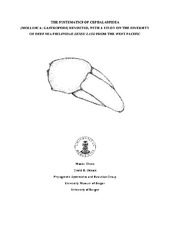| dc.description.abstract | The Cephalaspidea are the second most diverse marine clade of the Euthyneura gastropods, after the Nudipleura with many groups still known largely from shells or little anatomical data. These marine snails occur worldwide across all latitudes and depths. The definition of the group and the relationships between members has been hampered by the difficulty of establishing sound synapomorphies, but the advent of molecular phylogenetics in recent times has helped changed significantly this situation. Yet, because of reduced taxon sampling and few genetic markers employed in previous studies many questions about the sister relationships and monophyletic status of several families remained open. In this study over 100 taxa were included covering 100% of the traditionally recognized valid families and about 50% of the genera. The goals were to (1) produce a new hypothesis of relationships for the Cephalaspidea gastropods including for the first time representatives from all families by means of multilocus phylogenetic analyses (2) to infer relationships between families and test their monophyly, and (3) to study the diversity and systematics of the elusive deep sea West Pacific Philinidae sensu lato cephalaspids. Bayesian molecular phylogenetics based on two mitochondrial (COI, 16S rRNA) and two nuclear gene markers (28S rRNA and Histone-3) was used to infer the relationships of Cephalaspidea and to aid on species delimitation within Philinidae s. l.. Additionally, species of the Philinidae s. l. were studied by fine anatomical dissection and scanning electron microscopy. The monophyly of the Cephalaspidea without Runcinacea was confirmed. The families Cylichnidae, Diaphanidae, Haminoeidae, Philinidae, Retusidae, and Scaphandridae were found to be not monophyletic. This result suggests that the family level taxonomy of the Cephalaspidea warrants a profound revision and several new family and genera names are required to reflect the new phylogenetic hypothesis presented in this work. Philinidae s. l. was polyphyletic with four independent main lineages (family level) and seven genera. The generic names Hermania, Laona, Philinorbis, and Praephiline are reinstated as valid. Sixteen species of deep sea West Pacific Philinidae s. l were recognized of which 13 are putatively new to Science, emphasising how little is still known about the biodiversity of the deep sea in the tropical Indo-Pacific. | en_US |
